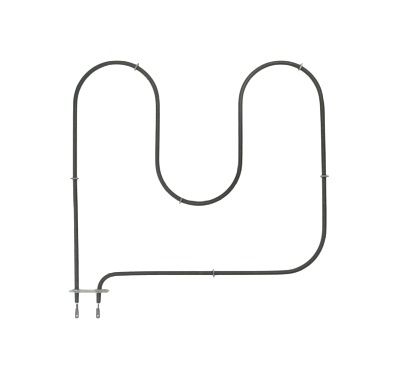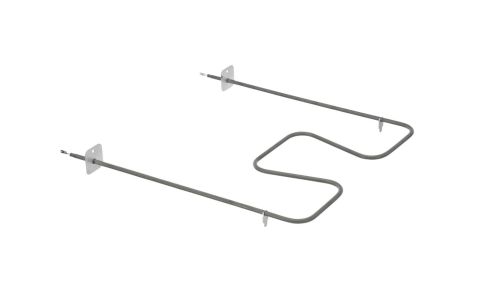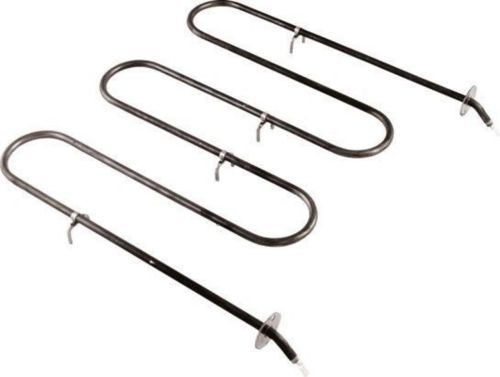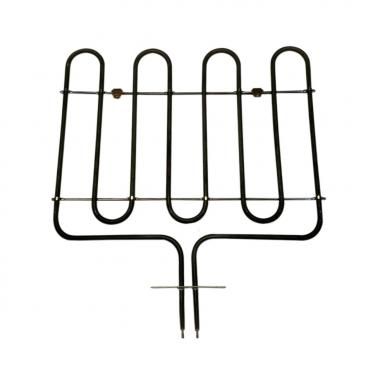
How to Replace Heating Element in Dishwasher
Replacing a dishwasher heating element is a straightforward process that can restore your appliance's efficiency. The heating element is vital for achieving optimal cleaning and drying results. In this guide, we'll walk you through the steps to safely replace the heating element in your dishwasher. From gathering the necessary tools to disconnecting the power, our instructions will help you navigate through the dishwasher heating element repair process smoothly. Save on costly repairs by tackling this DIY task with confidence, ensuring your dishwasher operates at peak performance.
| Table Of Contents What is a Dishwasher Heating Element & How Does it Work? Signs Your Dishwasher Heating Element is Faulty Safety Precautions Before Replacing Heating Element in Dishwasher How to fix heating element in dishwasher? Dishwasher Heating Element Troubleshooting Tips Maintenance Tips to Prolong Dishwasher Heating Element's Life |
What is a dishwasher heating element & how does it work?
The heating element for dishwasher is a crucial component responsible for elevating water temperature during the wash and rinse cycles. Typically located at the base of the dishwasher, this element heats water to enhance cleaning efficacy and aids in the drying process. Operating on electrical resistance, the heating element warms up when an electric current passes through it. As water circulates around the element, it absorbs heat, optimizing detergent efficiency and promoting hygienic dishwashing. Understanding the role of the heating element sheds light on its importance in maintaining a functional and efficient dishwasher for spotless, dry dishes after every cycle.
Are you looking for dishwasher parts near you online? Hnk parts is your one stop solution for home appliance needs. We offer wide range of dishwasher replacement part such as pump filter, impeller, seals and gaskets, drain filter, and upper and lower rinse arms and many more. Our inventory is sourced from top-selling manufacturers at competitive prices.
Signs your dishwasher heating element is faulty
Your dishwasher's heating element plays a crucial role in ensuring your dishes come out clean and sanitized after each wash. When dishwasher not getting hot or malfunctions, it can lead to various issues that affect the efficiency of your dishwasher. Recognizing the signs of a faulty heating element is essential to address the problem promptly and avoid further damage.
Dishwasher not heating or drying:
If you find your dishwasher not heating or drying dishes properly, it may be a sign that the heating element is not reaching the required temperature to evaporate the water.
Extended Cycle Duration:
A malfunctioning heating element can prolong the dishwasher's cycle duration. If your dishwasher takes significantly longer to complete a cycle than usual, it may be struggling to reach and maintain the necessary temperature for effective cleaning.
Cold Interior:
A broken heating element dishwasher often results in a cold or lukewarm interior after the cycle.
Residue and Cloudy Dishes:
Inspect your dishes for residue or cloudiness after each wash. A malfunctioning heating element can lead to insufficient water heating, resulting in detergent residue on your dishes and glassware.
Unpleasant Odors:
Ineffective heating can create a breeding ground for bacteria, leading to unpleasant odors inside your dishwasher. If you notice a persistent foul smell even after cleaning, it could be a sign that the heating element is not performing optimally.
Visible Damage:
Look for cracks or discolored areas on the heating element to confirm it’s time for dishwasher heating element replacement.
Read more about Dishwasher installation cost
Safety precautions before replacing heating element in dishwasher
Undertaking any appliance repair involves inherent risks, and dishwasher heating element replacement is no exception. Prioritizing safety is crucial for any appliance repair. Follow these safety steps before starting your dishwasher heating element repair:
Disconnect Dishwasher Power:
Before starting any repair work, ensure that the power supply to your dishwasher is completely cut off. Locate the breaker that supplies power to the dishwasher in your breaker box and switch it off. This precautionary measure significantly reduces the risk of electrocution during the repair process.
Switch Off the Water:
Turning off the water supply to the dishwasher is vital to avoid spills and water-related accidents. Locate the water valve nearest to your dishwasher, typically under the sink, and shut it off. This step is crucial for disconnecting the water supply, allowing you to move the dishwasher without the risk of water leaks.
Ensure Visible Power Cable Is Disconnected:
While turning off the breaker is a primary safety step, visually confirm that the power cable is disconnected from the dishwasher. This extra check ensures an added layer of safety, especially if you're dealing with a hard-to-reach or concealed power connection.
Wear Protective Gear:
Protect yourself by wearing appropriate safety gear, including gloves and safety goggles. These precautions safeguard against potential injuries, especially when dealing with electrical components or water-related tasks.
Secure a Well-Lit Workspace:
Adequate lighting is essential for a safe and effective repair. Ensure your workspace is well-lit to identify and navigate the components easily. This minimizes the risk of accidental injuries and ensures precision during the heating element replacement.
Refer to Manufacturer's Guidelines:
Confirm the dishwasher heating element location for your specific model using the manufacturer's manual.
Read more about How To Clean A Dryer Vent Yourself
How to fix heating element in dishwasher?
Replacing a dishwasher heating element may seem like a daunting task, but with the right guidance, it can be a manageable DIY project. Follow these step-by-step instructions & find out how to replace heating element in dishwasher successfully and restore efficient performance.
Step 1: Gather your materials
Before you begin dishwasher heating element replacement, make sure you have all the necessary materials and tools. You'll likely need a screwdriver, pliers, and the replacement heating element specific to your dishwasher model. Having everything on hand will streamline the process and save you from multiple trips back and forth.
Step 2: Turn off the power supply
Safety should always be a top priority when working with electrical appliances. Locate the circuit breaker or fuse that supplies power to your dishwasher and turn it off. This precautionary measure ensures your safety and prevents electrical mishaps during the replacement process.
Step 3: Remove the lower access panel
Most dishwashers have a lower access panel that covers the heating element. Use a screwdriver to carefully remove the screws holding the panel in place. Once removed, set the panel aside. This will expose the internal components of the dishwasher, including the heating element.
Step 4: Disconnect the electrical connections
Identify the electrical connections attached to the heating element. These connections may be secured with wire nuts or clips. Use pliers to carefully disconnect the wires. Remember to take note of the arrangement and placement of the wires for reference during reconnection.
Step 5: Remove the old heating element
With the electrical connections detached, you can now remove the old heating element. Depending on your dishwasher model, it may be secured by screws or clips. Use the appropriate tools to release and extract the old element from its housing.
Step 6: Install the new heating element
Carefully position the new heating element in the same location where the old one was removed. Secure it in place using the appropriate fasteners, such as screws or clips. Ensure a snug fit to guarantee optimal performance.
Step 7: Reconnect the electrical connections
Refer to your earlier notes or documentation to reconnect the wires to the new heating element. Use pliers to secure the connections, ensuring they are tight and well-insulated to prevent any electrical issues.
Step 8: Replace the lower access panel
Place the lower access panel back in its original position and secure it with the screws you removed earlier. This panel not only conceals the internal components but also provides structural support to the dishwasher.
Step 9: Restore power supply
Once the lower access panel is securely in place and all electrical connections are confirmed, return to the circuit breaker or fuse box. Switch the power supply back on to restore electricity to the dishwasher.
By following these steps carefully, you can successfully replace your dishwasher's heating element and enjoy efficient and reliable performance once again.
Dishwasher heating element troubleshooting tips
A malfunctioning dishwasher heating element can disrupt the efficiency of your appliance and compromise the quality of your dishes. If you suspect a dishwasher heating element test is needed, follow these tips:
1. Check for Power Supply Issues:
Ensure that your dishwasher is receiving an adequate power supply. Verify that the circuit breaker hasn't tripped and that there are no issues with the electrical outlet. If the dishwasher is hardwired, inspect the wiring for any visible damage.
2. Examine the Heating Element for Visible Damage:
Inspect the heating element for any signs of visible damage, such as burns or breaks. A damaged heating element may need to be replaced. Be sure to turn off the power supply before conducting a visual inspection.
3. Test the Continuity of the Heating Element:
Use a multimeter to test dishwasher heating element without removing it. If the multimeter indicates an open circuit, the element likely needs replacement.
4. Verify the Thermistor and Thermostat:
Dishwashers have temperature sensors, such as thermistors and thermostats, that work in conjunction with the heating element. Check these components for proper functionality. A malfunctioning thermistor or thermostat can affect the heating element's performance.
5. Examine the Water Inlet Valve:
The water inlet valve controls the flow of water into the dishwasher. If it's not functioning correctly, it can impact the heating element's ability to heat the water. Ensure that the water inlet valve is free from clogs and is operating as intended.
6. Run the Dishwasher with Hot Water:
Sometimes, running the dishwasher with hot water before starting a cycle can help improve heating performance. This is especially useful if your dishwasher is connected to a cold water supply.
7. Clean the Dishwasher Interior:
Residue and mineral deposits on the dishwasher interior, including the heating element, can affect its efficiency. Regularly clean the interior, including the heating element, using dishwasher-safe cleaning agents.
8. Consult the Owner's Manual:
Refer to your dishwasher's owner's manual for specific troubleshooting guidance and instructions. The manual may provide insights into common issues and solutions tailored to your appliance model.
9. Seek Professional Assistance:
If troubleshooting efforts do not resolve the issue or if you are uncomfortable with the diagnostic process, it's advisable to seek professional assistance. Certified technicians can accurately assess and address more complex dishwasher problems.
When you notice the dishwasher not getting hot, these troubleshooting tips can help identify whether the issue lies in the heating element or other components.
Maintenance tips to prolong dishwasher heating element's life
To extend the lifespan of heating element and ensure efficient performance, Regular maintenance helps prevent premature dishwasher heating element replacement cost. Firstly, descale your dishwasher periodically to prevent mineral buildup on the heating element. Use a dishwasher cleaner to remove residue and maintain optimal functionality. Inspect the dishwasher's interior for debris, and clean the filter regularly.
Check out the Best way to clean dishwasher
Run the dishwasher with hot water occasionally to prevent clogs and enhance heating efficiency. Additionally, avoid overloading the dishwasher, as this can strain the heating element. By incorporating these simple dishwasher maintenance practices, you can significantly prolong the life of your dishwasher's heating element and enjoy consistent results.
Replacing a dishwasher heating element is a manageable DIY task with the right guidance. By following the outlined steps, from gathering materials to restoring power, you can ensure a smooth and successful replacement process. Regular maintenance is crucial to uphold the dishwasher's efficiency. With these steps, you not only resolve heating element issues but also contribute to the longevity and optimal performance of your dishwasher, saving time and ensuring clean dishes for years to come.
FAQs
Is it worth replacing heating element in dishwasher?
Whether it's worth replacing a dishwasher heating element depends on the appliance's age and overall condition, considering repair costs versus a new unit.
How much does dishwasher heating element replacement cost?
The dishwasher heating element replacement cost varies but generally ranges from $100 to $200, including parts and labor.
How to tell if dishwasher heating element is bad?
Signs of a broken dishwasher heating element include damp dishes, longer cycles, unusual noises, visual damage, and a burnt smell during operation.
where is the heating element on a dishwasher?
The heating element is typically located at the bottom of the dishwasher, near the base of the tub.
How to test dishwasher heating element without removing?
Use a multimeter to check for continuity. Unplug the dishwasher, access the heating element terminals, and place the multimeter probes on the terminals. A reading between 10-50 ohms indicates the element is functioning properly











